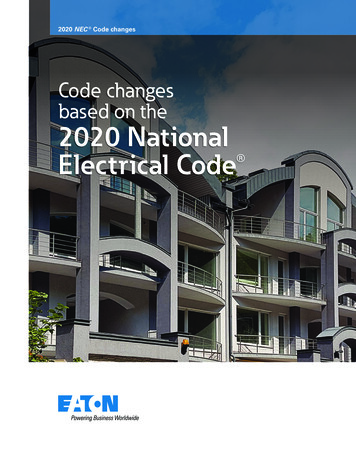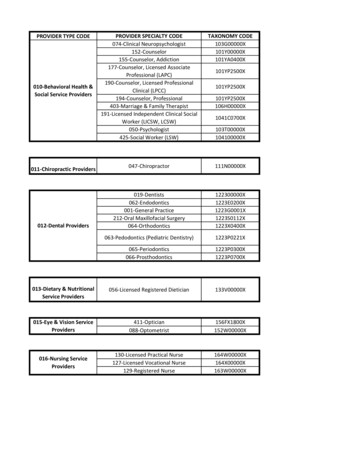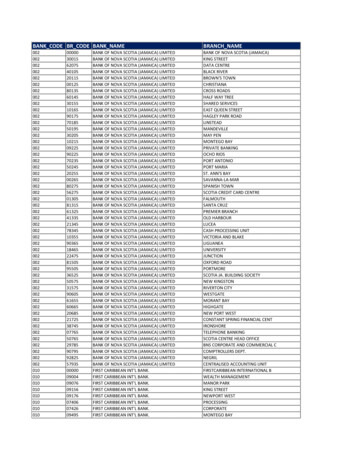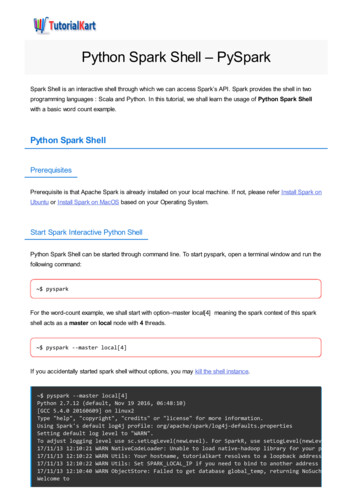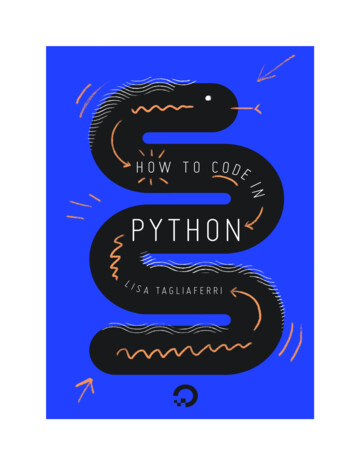
Transcription
How To Code in Python 3Lisa TagliaferriDigitalOcean, New York City, New York, USA
This work is licensed under a Creative Commons Attribution-NonCommercial-ShareAlike 4.0International License.ISBN 978-0-9997730-1-7
About DigitalOceanDigitalOcean is a cloud services platform delivering the simplicitydevelopers love and businesses trust to run production applications atscale. It provides highly available, secure and scalable compute, storageand networking solutions that help developers build great softwarefaster. Founded in 2012 with offices in New York and Cambridge, MA,DigitalOcean offers transparent and affordable pricing, an elegant userinterface, and one of the largest libraries of open source ttps://www.digitalocean.com or follow @digitalocean on ahttps://do.co/python-book.DigitalOcean Community TeamDirector of Community: Etel SverdlovTechnical Writers: Melissa Anderson, Brian Boucheron, Mark Drake,Justin Ellingwood, Katy Howard, Lisa TagliaferriTechnical Editors: Brian Hogan, Hazel Virdó
How To Code in Python 31. Introduction2. Python 2 vs Python 3: Practical Considerations3. How To Install Python 3 and Set Up a Local ProgrammingEnvironment on Ubuntu 16.044. How To Install Python 3 and Set Up a Local ProgrammingEnvironment on macOS5. How To Install Python 3 and Set Up a Local ProgrammingEnvironment on Windows 106. How To Install Python 3 and Set Up a Local ProgrammingEnvironment on CentOS 77. How To Install Python 3 and Set Up a Programming Environment onan Ubuntu 16.04 Server8. How To Write Your First Python 3 Program9. How To Work with the Python Interactive Console10. How To Write Comments11. Understanding Data Types12. An Introduction to Working with Strings13. How To Format Text14. An Introduction to String Functions15. How To Index and Slice Strings16. How To Convert Data Types17. How To Use Variables18. How To Use String Formatters19. How To Do Math with Operators20. Built-in Python 3 Functions for Working with Numbers
21. Understanding Boolean Logic22. Understanding Lists23. How To Use List Methods24. Understanding List Comprehensions25. Understanding Tuples26. Understanding Dictionaries27. How To Import Modules28. How To Write Modules29. How To Write Conditional Statements30. How To Construct While Loops31. How To Construct For Loops32. How To Use Break, Continue, and Pass Statements when Workingwith Loops33. How To Define Functions34. How To Use *args and **kwargs35. How To Construct Classes and Define Objects36. Understanding Class and Instance Variables37. Understanding Inheritance38. How To Apply Polymorphism to Classes39. How To Use the Python Debugger40. How To Debug Python with an Interactive Console41. How To Use Logging42. How To Port Python 2 Code to Python 3
IntroductionWhy Learn To CodeSoftware and technology are becoming increasingly integrated into oureveryday lives, allowing us to accomplish tasks, navigate to destinations,make purchases, and stay connected with friends. Because of howpervasive software now is to the human experience, it is important for allof us to learn some of the key foundational elements of computerprogramming. While some may choose to study computer science as partof their formal education, everyone can benefit from an understanding ofalgorithmic thinking and computational processes. Learning how thesoftware that we use on a daily basis is made can allow us as end users toevaluate how and why these applications are developed, enabling us tothink critically about these tools and how to improve them.Just like any other product, computer programs are designed anddeveloped by people who have unconscious biases, make errors, andmay not be considering all aspects of a problem they are trying to solve.Though development teams may do thorough testing and work to createsophisticated and useful programs, they do not always meet the needsand expectations of all users. While not everyone needs to learn to codecomplex programs, learning how coding works can help shape the futureof technology and increase the number of stakeholders, decision makers,and knowledge producers who can work to build better software foreveryone.Some of us may choose to solve challenging problems within thetechnology sector, but for those of us not working in computer science, a
programming background can still be a great asset to our professionalfields. Computer programming provides many applications acrossdomains, and can help us solve problems in specialities such as medicine,economics, sociology, history, and literature, to name a few. Byintegrating technology’s methodologies into our own fields, we canleverage computational logic and software design and developmentpractices in our work. When we synthesize knowledge across spheresand collaborate with people from different backgrounds, we can innovatein new, more inclusive ways that can enact meaningful impact acrossmany communities.Why Learn PythonExtremely versatile and popular among developers, Python is a goodgeneral-purpose language that can be used in a variety of applications.For those with an understanding of English, Python is a very humanreadable programming language, allowing for quick comprehension.Because Python supports multiple styles including scripting and objectoriented programming, it is considered to be a multi-paradigm languagethat enables programmers to use the most suitable style to complete aproject. Increasingly used in industry, Python offers a lot of potential forthose who would like to begin coding while also being a good choice forthose looking to pick up an additional programming language.Learning the key concepts of Python can help you understand howprograms work while also imparting foundational logic that can serveyou in other domains. Understanding what Python and computerprogramming can offer you both as a user and as a developer isimportant as technology is further integrated into daily life.
As you work through this book, you will be able to increase yourawareness of computer programming, improve your logical thinking,and eventually become a producer of software. Being able to createsoftware that runs is a very rewarding endeavor, and can help you servethose around you by increasing their access and empowering them tobecome collaborators. The more communities involved in the creation ofsoftware development, the more communities there will be whose needsare served by software.How To Use This BookThis book is designed to be used in a way that makes sense for you.While it is arranged to ramp up an emerging developer, do not beconstrained by the order: feel free to move throughout the book in a waythat makes sense for you. Once you are familiar with the concepts, youcan continue to use the book as a source of reference.If you use the book in the order it is laid out, you’ll begin yourexploration in Python by understanding the key differences betweenPython 3 and the previous versions of the language. From there, you’llset up a programming environment for your relevant local or serverbased system, and begin by learning general Python code structure,syntax, and data types. Along the way, you’ll gain a solid grounding incomputational logic within Python, which can help you learn otherprogramming languages. While the beginning of the book focuses onscripting in Python, the end of the book will take you through objectoriented coding in Python, which can make your code more modular,flexible, and complex without repetition. By the end of the book, you’lllearn how to debug your Python code and finally how to port Pythoncode across versions.
When you are done with the book, we encourage you to look atproject-based tutorials to put your knowledge into play while creatingprojects that can help you solve problems. While you are working onthese projects, you can continue to refer to the chapters in this book asreference material.As part of your learning process and once you feel comfortable, werecommend that you contribute to an open-source project to improveprograms and drive greater access via software and technicaldocumentation pull requests or repository maintenance. Our communityis bigger than just us and building software together can make sure thateveryone has an opportunity to participate in the technology we useevery day.
Python 2 vs Python 3: PracticalConsiderationsPython is an extremely readable and versatile programming language.With a name inspired by the British comedy group Monty Python, it wasan important foundational goal of the Python development team to makethe language fun to use. Easy to set up, and written in a relativelystraightforward style with immediate feedback on errors, Python is agreat choice for beginners.As Python is a multiparadigm language — that is, it supports multipleprogramming styles including scripting and object-oriented — it is goodfor general purpose use. Increasingly used in industry by organizationssuch as United Space Alliance (NASA’s main shuttle support contractor),and Industrial Light & Magic (the VFX and animation studio ofLucasfilm), Python offers a lot of potential for those looking to pick up anadditional programming language.Developed in the late 1980s and first published in 1991, Python wasauthored by Guido van Rossum, who is still very active in thecommunity. Conceived as a successor to the ABC programminglanguage, Python’s first iteration already included exception handling,functions, and classes with inheritance. When an important Usenetnewsgroup discussion forum called comp.lang.python was formed in1994, Python’s user base grew, paving the way for Python to become oneof the most popular programming languages for open sourcedevelopment.General Overview
Before looking into potential opportunities related to — and the keyprogrammatic differences between — Python 2 and Python 3, let’s take alook into the background of the more recent major releases of Python.Python 2Published in late 2000, Python 2 signalled a more transparent andinclusive language development process than earlier versions of Pythonwith the implementation of PEP (Python Enhancement Proposal), atechnical specification that either provides information to Pythoncommunity members or describes a new feature of the language.Additionally, Python 2 included many more programmatic featuresincluding a cycle-detecting garbage collector to automate memorymanagement, increased Unicode support to standardize characters, andlist comprehensions to create a list based on existing lists. As Python 2continued to develop, more features were added, including unifyingPython’s types and classes into one hierarchy in Python version 2.2.Python 3Python 3 is regarded as the future of Python and is the version of thelanguage that is currently in development. A major overhaul, Python 3was released in late 2008 to address and amend intrinsic design flaws ofprevious versions of the language. The focus of Python 3 developmentwas to clean up the codebase and remove redundancy, making it clearthat there was only one way to perform a given task.Major modifications to Python 3.0 included changing the printstatement into a built-in function, improve the way integers are divided,and providing more Unicode support.
At first, Python 3 was slowly adopted due to the language not beingbackwards compatible with Python 2, requiring people to make adecision as to which version of the language to use. Additionally, manypackage libraries were only available for Python 2, but as thedevelopment team behind Python 3 has reiterated that there is an end oflife for Python 2 support, more libraries have been ported to Python 3.The increased adoption of Python 3 can be shown by the number ofPython packages that now provide Python 3 support, which at the timeof writing includes 339 of the 360 most popular Python packages.Python 2.7Following the 2008 release of Python 3.0, Python 2.7 was published onJuly 3, 2010 and planned as the last of the 2.x releases. The intentionbehind Python 2.7 was to make it easier for Python 2.x users to portfeatures over to Python 3 by providing some measure of compatibilitybetween the two. This compatibility support included enhanced modulesfor version 2.7 like unittest to support test automation, argparse forparsing command-line options, and more convenient classes incollections.Because of Python 2.7’s unique position as a version in between theearlier iterations of Python 2 and Python 3.0, it has persisted as a verypopular choice for programmers due to its compatibility with manyrobust libraries. When we talk about Python 2 today, we are typicallyreferring to the Python 2.7 release as that is the most frequently usedversion.Python 2.7, however, is considered to be a legacy language and itscontinued development, which today mostly consists of bug fixes, willcease completely in 2020.
Key DifferencesWhile Python 2.7 and Python 3 share many similar capabilities, theyshould not be thought of as entirely interchangeable. Though you canwrite good code and useful programs in either version, it is worthunderstanding that there will be some considerable differences in codesyntax and handling.Below are a few examples, but you should keep in mind that you willlikely encounter more syntactical differences as you continue to learnPython.PrintIn Python 2, print is treated as a statement instead of a function, whichwas a typical area of confusion as many other actions in Python requirearguments inside of parentheses to execute. If you want your console toprint out Sammy the Shark is my favorite sea creatureinPython 2 you can do so with the following print statement:print "Sammy the Shark is my favorite sea creature"With Python 3, print() is now explicitly treated as a function, so toprint out the same string above, you can do so simply and easily usingthe syntax of a function:print("Sammy the Shark is my favorite sea creature")This change made Python’s syntax more consistent and also made iteasier to change between different print functions. Conveniently, the
print() syntax is also backwards-compatible with Python 2.7, so yourPython 3 print() functions can run in either version.Division with IntegersIn Python 2, any number that you type without decimals is treated as theprogramming type called integer. While at first glance this seems like aneasy way to handle programming types, when you try to divide integerstogether sometimes you expect to get an answer with decimal places(called a float), as in:5 / 2 2.5However, in Python 2 integers were strongly typed and would notchange to a float with decimal places even in cases when that wouldmake intuitive sense.When the two numbers on either side of the division / symbol areintegers, Python 2 does floor division so that for the quotient x thenumber returned is the largest integer less than or equal to x. This meansthat when you write 5 / 2 to divide the two numbers, Python 2.7returns the largest integer less than or equal to 2.5, in this case 2:a 5 / 2print aOutput2
To override this, you could add decimal places as in 5.0 / 2.0 to getthe expected answer 2.5.In Python 3, integer division became more intuitive, as in:a 5 / 2print(a)Output2.5You can still use 5.0 / 2.0 to return 2.5, but if you want to do floordivision you should use the Python 3 syntax of //, like this:b 5 // 2print(b)Output2This modification in Python 3 made dividing by integers much moreintuitive and is a feature that is not backwards compatible with Python2.7.Unicode SupportWhen programming languages handle the string type — that is, asequence of characters — they can do so in a few different ways so thatcomputers can convert numbers to letters and other symbols.
Python 2 uses the ASCII alphabet by default, so when you type"Hello, Sammy!" Python 2 will handle the string as ASCII. Limited toa couple of hundred characters at best in various extended forms, ASCIIis not a very flexible method for encoding characters, especially nonEnglish characters.To use the more versatile and robust Unicode character encoding,which supports over 128,000 characters across contemporary and historicscripts and symbol sets, you would have to type u"Hello, Sammy!",with the u prefix standing for Unicode.Python 3 uses Unicode by default, which saves programmers extradevelopment time, and you can easily type and display many morecharacters directly into your program. Because Unicode supports greaterlinguistic character diversity as well as the display of emojis, using it asthe default character encoding ensures that mobile devices around theworld are readily supported in your development projects.If you would like your Python 3 code to be backwards-compatible withPython 2, though, you can keep the u before your string.Continued DevelopmentThe biggest difference between Python 3 and Python 2 is not a syntacticalone, but the fact that Python 2.7 will lose continued support in 2020 andPython 3 will continue to be developed with more features and more bugfixes.Recent developments have included formatted string literals, simplercustomization of class creation, and a cleaner syntactical way to handlematrix multiplication.Continued development of Python 3 means that developers can rely onhaving issues fixed in a timely manner, and programs can be more
effective with increased functionality being built in over time.Additional Points to ConsiderAs someone starting Python as a new programmer, or an experiencedprogrammer new to the Python language, you will want to considerwhat you are hoping to achieve in learning the language.If you are hoping just to learn without a set project in mind, you willlikely most want to take into account that Python 3 will continue to besupported and developed, while Python 2.7 will not.If, however, you are planning to join an existing project, you will likelymost want to see what version of Python the team is using, how adifferent version may interact with the legacy codebase, if the packagesthe project uses are supported in a different version, and what theimplementation details of the project are.If you are beginning a project that you have in mind, it would beworthwhile to investigate what packages are available to use and withwhich version of Python they are compatible. As noted above, thoughearlier versions of Python 3 had less compatibility with libraries built forversions of Python 2, many have ported over to Python 3 or arecommitted to doing so in the next four years.ConclusionPython is a versatile and well-documented programming language tolearn, and whether you choose to work with Python 2 or Python 3, youwill be able to work on exciting software projects.Though there are several key differences, it is not too difficult to movefrom Python 3 to Python 2 with a few tweaks, and you will often findthat Python 2.7 can easily run Python 3 code, especially when you are
starting out. You can learn more about this process by reading the tutorialHow To Port Python 2 Code to Python 3.It is important to keep in mind that as more developer and communityattention focuses on Python 3, the language will become more refinedand in-line with the evolving needs of programmers, and less supportwill be given to Python 2.7.
How To Install Python 3 and Set Up a LocalProgramming Environment on Ubuntu 16.04This tutorial will get you up and running with a local Python 3programming environment in Ubuntu 16.04.Python is a versatile programming language that can be used for manydifferent programming projects. First published in 1991 with a nameinspired by the British comedy group Monty Python, the developmentteam wanted to make Python a language that was fun to use. Easy to setup, and written in a relatively straightforward style with immediatefeedback on errors, Python is a great choice for beginners andexperienced developers alike. Python 3 is the most current version of thelanguage and is considered to be the future of Python.This tutorial will guide you through installing Python 3 on your localLinux machine and setting up a programming environment via thecommand line. This tutorial will explicitly cover the installationprocedures for Ubuntu 16.04, but the general principles apply to anyother distribution of Debian Linux.PrerequisitesYou will need a computer with Ubuntu 16.04 installed, as well as haveadministrative access to that machine and an internet connection.Step 1 — Setting Up Python 3We’ll be completing our installation and setup on the command line,which is a non-graphical way to interact with your computer. That is,
instead of clicking on buttons, you’ll be typing in text and receivingfeedback from your computer through text as well. The command line,also known as a shell, can help you modify and automate many of thetasks you do on a computer every day, and is an essential tool forsoftware developers. There are many terminal commands to learn thatcan enable you to do more powerful things. The article “An Introductionto the Linux Terminal” can get you better oriented with the terminal.On Ubuntu 16.04, you can find the Terminal application by clicking onthe Ubuntu icon in the upper-left hand corner of your screen and typing“terminal” into the search bar. Click on the Terminal application icon toopen it. Alternatively, you can hit the CTRL, ALT, and T keys on yourkeyboard at the same time to open the Terminal applicationautomatically.Ubuntu Terminal
Ubuntu 16.04 ships with both Python 3 and Python 2 pre-installed. Tomake sure that our versions are up-to-date, let’s update and upgrade thesystem with apt-get:sudo apt-get updatesudo apt-get -y upgradeT h e -y flag will confirm that we are agreeing for all items to beinstalled, but depending on your version of Linux, you may need toconfirm additional prompts as your system updates and upgrades.Once the process is complete, we can check the version of Python 3that is installed in the system by typing:python3 -VYou will receive output in the terminal window that will let you knowthe version number. The version number may vary, but it will looksimilar to this:OutputPython 3.5.2To manage software packages for Python, let’s install pip:sudo apt-get install -y python3-pipA tool for use with Python, pip installs and manages programmingpackages we may want to use in our development projects. You can
install Python packages by typing:pip3 install package nameHere, package name can refer to any Python package or library, suchas Django for web development or NumPy for scientific computing. So ifyou would like to install NumPy, you can do so with the command pip3install numpy.There are a few more packages and development tools to install toensure that we have a robust set-up for our programming environment:sudo apt-get install build-essential libssl-devlibffi-dev python-devOnce Python is set up, and pip and other tools are installed, we can setup a virtual environment for our development projects.Step 2 — Setting Up a Virtual EnvironmentVirtual environments enable you to have an isolated space on yourcomputer for Python projects, ensuring that each of your projects canhave its own set of dependencies that won’t disrupt any of your otherprojects.Setting up a programming environment provides us with greatercontrol over our Python projects and over how different versions ofpackages are handled. This is especially important when working withthird-party packages.You can set up as many Python programming environments as youwant. Each environment is basically a directory or folder in your
computer that has a few scripts in it to make it act as an environment.We need to first install the venv module, part of the standard Python 3library, so that we can create virtual environments. Let’s install venv bytyping:sudo apt-get install -y python3-venvWith this installed, we are ready to create environments. Let’s choosewhich directory we would like to put our Python programmingenvironments in, or we can create a new directory with mkdir, as in:mkdir environmentscd environmentsOnce you are in the directory where you would like the environmentsto live, you can create an environment by running the followingcommand:python3 -m venv my envEssentially, this sets up a new directory that contains a few itemswhich we can view with the ls command:ls my envOutputbin include lib lib64 pyvenv.cfg share
Together, these files work to make sure that your projects are isolatedfrom the broader context of your local machine, so that system files andproject files don’t mix. This is good practice for version control and toensure that each of your projects has access to the particular packagesthat it needs. Python Wheels, a built-package format for Python that canspeed up your software production by reducing the number of times youneed to compile, will be in the Ubuntu 16.04 share directory.To use this environment, you need to activate it, which you can do bytyping the following command that calls the activate script:source my env/bin/activateYour prompt will now be prefixed with the name of your environment,in this case it is called my env. Your prefix may look somewhat different,but the name of your environment in parentheses should be the firstthing you see on your line:(my env) sammy@sammy: /environments This prefix lets us know that the environment my env is currentlyactive, meaning that when we create programs here they will use onlythis particular environment’s settings and packages.Note: Within the virtual environment, you can use the commandpython instead of python3, and pip instead of pip3 if you wouldprefer. If you use Python 3 on your machine outside of an environment,you will need to use the python3 and pip3 commands exclusively.After following these steps, your virtual environment is ready to use.
Step 3 — Creating a Simple ProgramNow that we have our virtual environment set up, let’s create a simple“Hello, World!” program. This will make sure that our environment isworking and gives us the opportunity to become more familiar withPython if we aren’t already.To do this, we’ll open up a command-line text editor such as nano andcreate a new file:(my env) sammy@sammy: /environments nano hello.pyOnce the text file opens up in the terminal window we’ll type out ourprogram:print("Hello, World!")Exit nano by typing the control and x keys, and when prompted tosave the file press y.Once you exit out of nano and return to your shell, let’s run theprogram:(my env) sammy@sammy: /environments python hello.pyThe hello.py program that you just created should cause your terminalto produce the following output:OutputHello, World!
To leave the environment, simply type the command deactivate andyou will return to your original directory.ConclusionCongratulations! At this point you have a Python 3 programmingenvironment set up on your local Ubuntu machine and can begin acoding project!To set up Python 3 on another computer, follow the local programmingenvironment guides for Debian 8, CentOS 7, Windows 10, or macOS. Youcan also read about installing Python and setting up a programmingenvironment on an Ubuntu 16.04 server, which is especially useful whenworking on development teams.With your local machine ready for software development, you cancontinue to learn more about coding in Python by following“Understanding Data Types in Python 3” and “How To Use Variables inPython 3”.
How To Install Python 3 and Set Up a LocalProgramming Environment on macOSPython is a versatile programming language that can be used for manydifferent programming projects. First published in 1991 with a nameinspired by the British comedy group Monty Python, the developmentteam wanted to make Python a language that was fun to use. Easy to setup, and written in a relatively straightforward style with immediatefeedback on errors, Python is a great choice for beginners andexperienced developers alike. Python 3 is the most current version of thelanguage and is considered to be the future of Python.This tutorial will guide you through installing Python 3 on your localmacOS machine and setting up a programming environment via thecommand line.PrerequisitesYou will need a macOS computer with administrative access that isconnected to the internet.Step 1 — Opening TerminalWe’ll be completing most of our installation and set up on the commandline, which is a non-graphical way to interact with your computer. Thatis, instead of clicking on buttons, you’ll be typing in text and receivingfeedback from your computer through text as well. The command line,also known as a shell, can help you modify and automate many of the
tasks you do on a computer every day, and is an essential tool forsoftware developers.The macOS Terminal is an application you can use to access thecommand line interface. Like any other application, you can find it bygoing into Finder, navigating to the Applications folder, and then into theUtilities folder. From here, double-click the Terminal like any otherapplication to open it up. Alternatively, you can use Spotlight by holdingdown the command and spacebar keys to find Terminal by typing it outin the box that appears.macOS TerminalThere are many more Terminal commands to learn that can enable youto do more powerful things. The article “An Introduction to the Linux
Terminal” can get you better oriented with the Linux Terminal, which issimilar to the macOS Terminal.Step 2 — Installing XcodeXcode is an integrated development environment (IDE) that is comprisedof software development tools for macOS. You may have Xcode installedalready. To check, in your Terminal window, type:xcode-select -pIf you receive the following output, then Xcode is sIf you received an error, then in your web browser install Xcode fromthe App Store and accept the default options.Once Xcode is installed, return to your Terminal window. Next, you’llneed to install Xco
exploration in Python by understanding the key differences between Python 3 and the previous versions of the language. From there, you’ll set up a programming environment for your relevant local or server-based system, and begin by learning general Python code structure, syntax, and da





